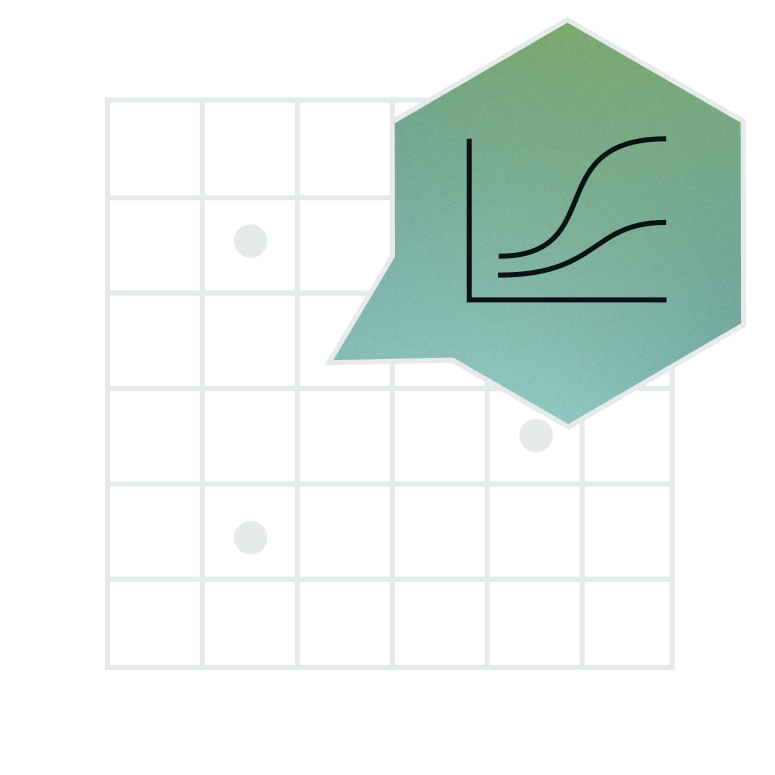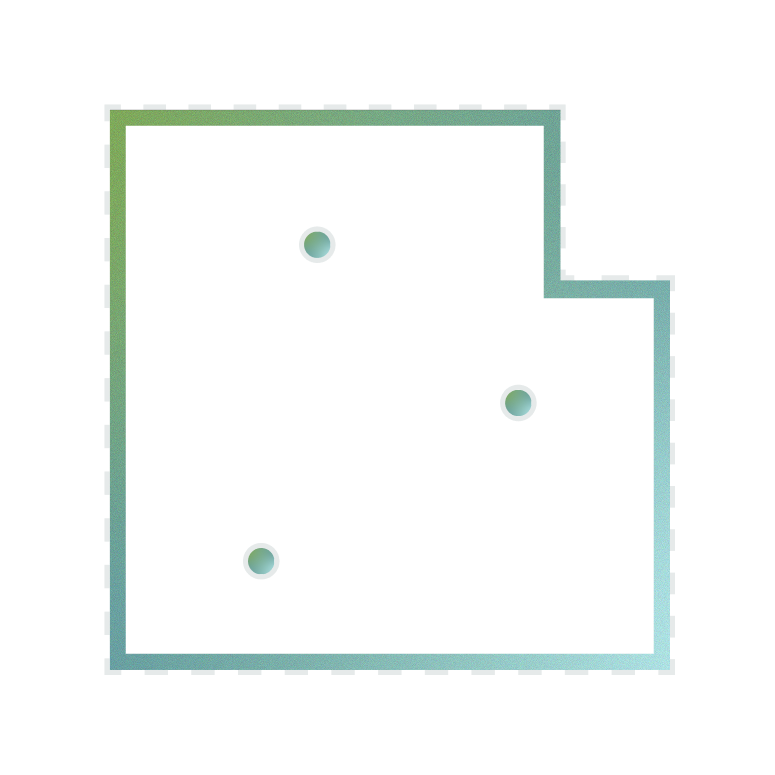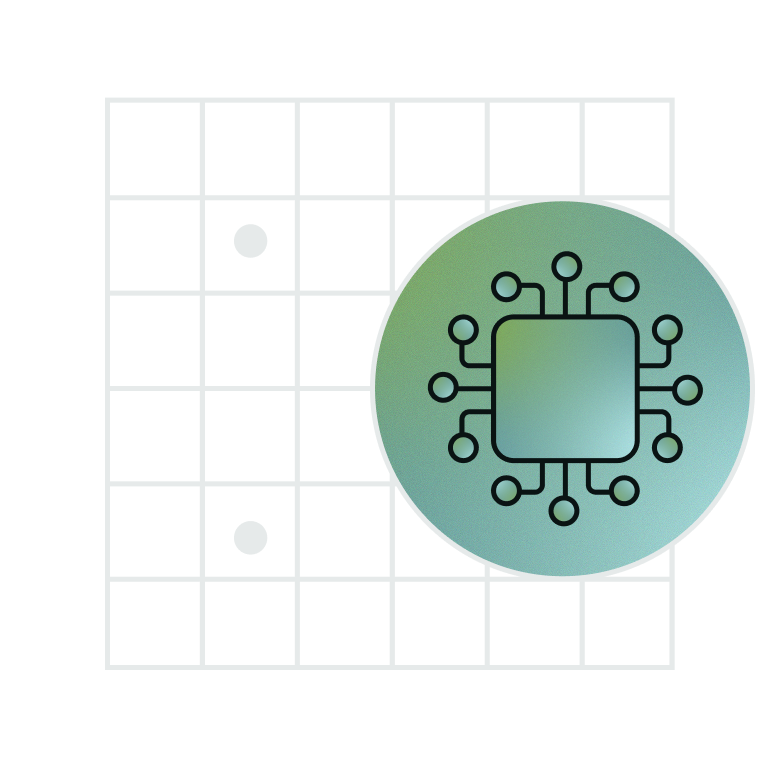How Perennial Provides MMRV Anywhere
Learn more about the tech, science, and workflows that power Perennial.
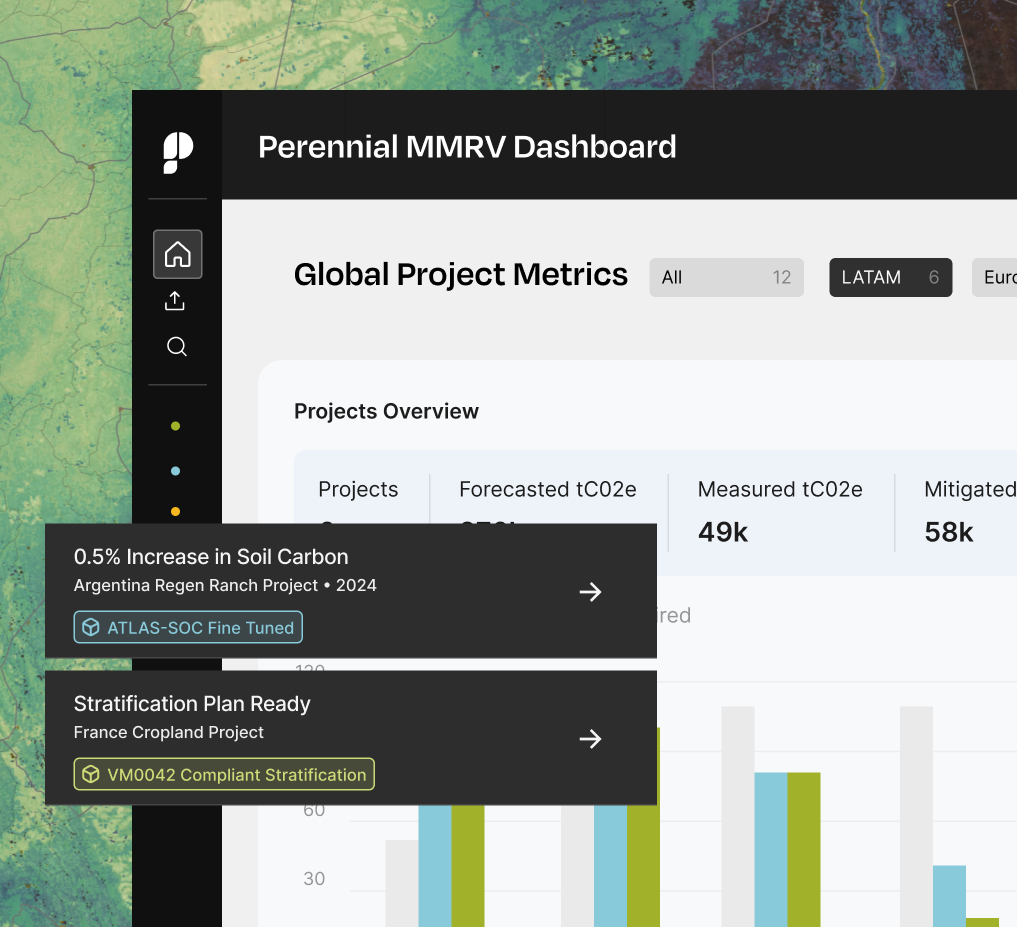

Validated.
Adaptable.
Built to scale.
We combine peer-reviewed science, digital tools, and trusted partnerships to help project developers and sustainability teams quantify regenerative outcomes with precision, scalability, and confidence.








An optimized foundation for every project
MMRV that adapts to meet your project’s needs
Learn more about the monitoring approaches below.
Enhancing accuracy & efficiency with Digital Soil Mapping
Digital soil mapping (DSM) is a low-sample, low-cost, low-uncertainty approach that scales across geographies, land types, and crops.
By quantifying all of the soil in a project rather than scattered points, and modeling uncertainty at a pixel level, DSM reduces uncertainty, lowers sampling needs, and strengthens accuracy.
Whether used on its own, alongside a biogeochemical model (BGCM), or as the destination for projects starting with point sampling, digital soil mapping is an upgrade for any soil carbon project.
+ High accuracy
+ Lower sample burden
+ Higher credit yield
+ Registry-aligned* (e.g. VM0042, VM0032, and more)
Digital Soil Mapping + Biogeochemical models
For projects already using biogeochemical models (BGCM) — or starting in crops and regions where they’re well-validated — digital soil mapping strengthens results while reducing reliance on dense sampling.
By filling in the gaps between and beyond sample points, DSM provides spatially rich SOC data that sharpens model calibration and minimizes assumptions.
Even when working with 10x fewer samples, we can generate up to 20x more SOC inputs for the biogeochemical model. Combined with pixel-level uncertainty modeling, this leads to sharper estimates, lower uncertainty, and greater confidence in results.
How it works:
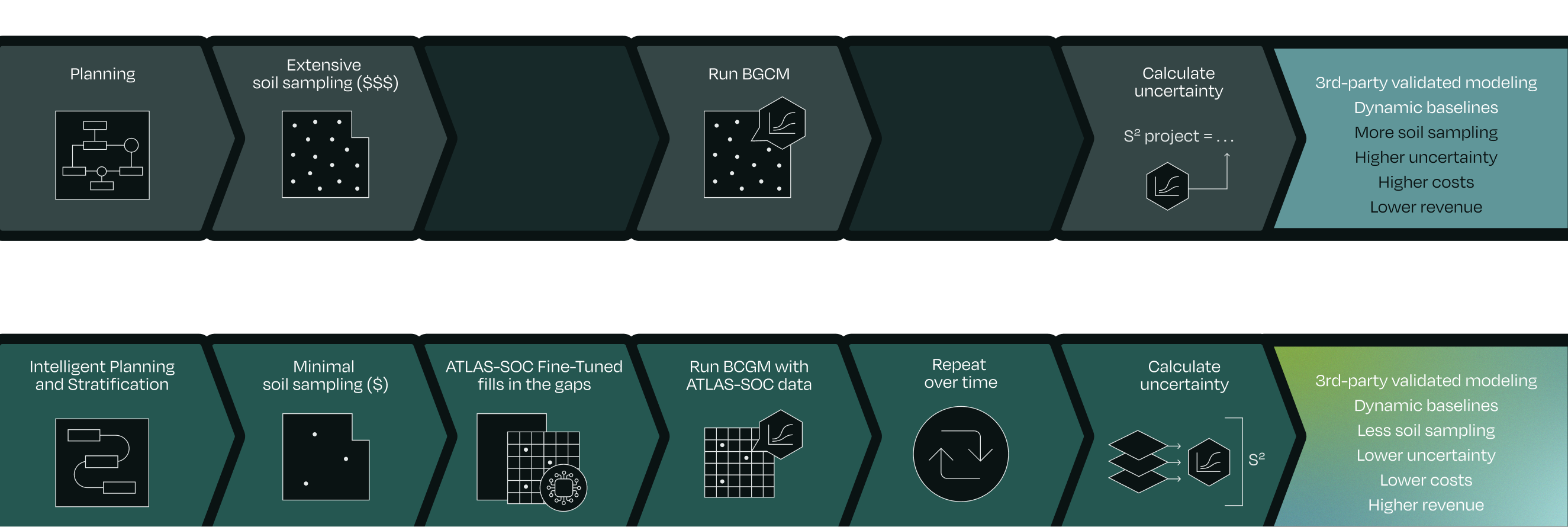
From Measure/Remeasure to Digital Soil Mapping
Projects that begin with measure–remeasure often face high sampling costs, operational complexity, and limited spatial resolution. Transitioning to digital soil mapping changes that.
By applying our digital soil mapping model to your existing samples, we can generate hundreds to thousands more SOC estimates — filling in the gaps between sample locations, modeling uncertainty pixel by pixel, and dramatically expanding coverage without resampling.
The result: lower uncertainty, lower costs, and a stronger foundation for future crediting.
Transitioning doesn’t mean starting over. It means getting more value from the data you already have — and unlocking a path to greater efficiency, scalability, and confidence.
How it works:
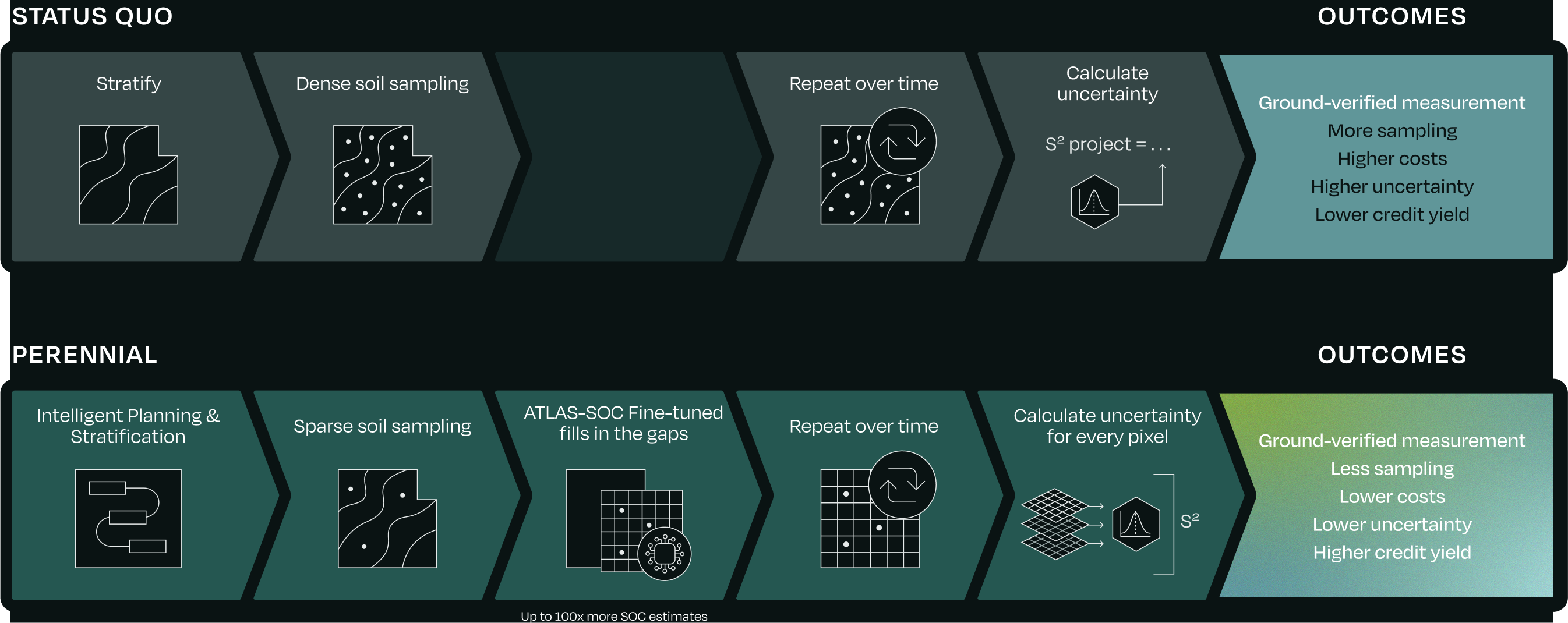
Starting with Measure-Remeasure
Perennial supports measure–remeasure when needed — particularly in early-stage projects or regions with limited data. Even with a samples-only approach, our optimized foundation helps reduce the sampling burden and streamline operations from day one, with improved stratification, QA/QC, end-to-end traceability, and more.
Each measurement event helps build a dataset that can support a future transition to digital soil mapping — preserving compliance while lowering cost and complexity.
+ Start where you are
+ Evolve toward digital soil mapping
+ Improve performance at every stage
→ Peer-reviewed paper on quantifying SOC using digital soil mapping
→ Peer-reviewed paper on calculating SOC beneath the soil surface
→ Perennial Soil Ecosystem Data technical documentation
→ AGU presentation on estimating sequestration potential with SOCSPOT
→ Correspondence in Nature on verifiability of soil carbon credits
Verra’s Digital Soil Mapping tool: built by Perennial
Developed with a global team of experts and shaped through public consultation, the tool is the first AI-enabled carbon quantification tool to be recognized by a major registry. VT0014 allows digital soil mapping to be used across the Verified Carbon Standard — for any ALM methodology that requires a SOC estimate, bulk density, or SOC stock.
Thousands of hours of research, testing, and stakeholder input went into its creation — helping unlock rigorous, scalable, registry-grade MMRV anywhere.

Meet ATLAS-SOC
Peer-reviewed, and third-party validated, ATLAS-SOC has now integrated over 350,000 soil samples.
Trusted by market leaders




Frequently asked questions

Do you still use soil samples?
Usually, yes — but far fewer than traditional approaches require. For projects that require Tier 3 measurements or registry compliance, we collect a small number of local samples to fine-tune our digital soil mapping model and meet program requirements.
For programs that don’t require Tier 3 or registry alignment, Perennial can deliver SOC stock estimates without any local soil sampling or farm data — reducing time, cost, and complexity even further.

Is digital soil mapping the only approach you use?
No.
We tailor the monitoring approach to each project. In addition to digital soil mapping, we support:
- Digital soil mapping combined with biogeochemical models
- Measure–remeasure (samples-only) workflows
- Mapped estimates of carbon sequestration potential and key soil health indicators on croplands and grazing lands worldwide
You don’t need to choose upfront — we’ll recommend the best path based on your land, data, and program requirements.

Can I use Perennial if I already work with a biogeochemical model?
Absolutely.
Perennial’s digital soil mapping model (ATLAS-SOC) can be used to initialize or true-up your biogeochemical model with high-resolution, field-level SOC data — reducing the need for dense sampling while improving model performance.
Our model fills in the gaps between sample locations, sharpening calibration and reducing reliance on assumptions. Even with fewer samples, we can generate hundreds to thousands of times more SOC data points across the project area — with uncertainty modeled at the pixel level.
We also support early-stage project setup — including smart stratification, sampling design, and field scouting — to streamline your workflow and ensure compatibility with registry-approved quantification approaches.

What happens if my project starts with measure–remeasure?
Measure–remeasure has helped many soil carbon projects get off the ground — but with dense sampling requirements, it’s expensive and complex to scale.
Transitioning to digital soil mapping builds on your existing sample data to dramatically expand coverage, reduce uncertainty, and lower future sampling needs.
That means lower costs, fewer disruptions for farmers, and a stronger foundation for long-term crediting.
Here’s how it works: We fine-tune our ATLAS-SOC model using your project’s local data. The localized model then fills in the gaps between sample points, generating hundreds to thousands of times more SOC estimates than sampling alone.
That denser dataset — combined with pixel-level uncertainty modeling — enables broader measurement coverage and reduced uncertainty, even when working with fewer samples.

What kinds of projects can Perennial support?
Perennial supports carbon and sustainability projects for any crop and any land use — across croplands, grasslands, and rangelands — anywhere on Earth.

Which standards and registries are you aligned with?
Perennial is compatible with a wide range of global standards and registries, including:
- Verra — any ALM methodology requiring SOC quantification, including VM0042, VM0032,, and anticipated under the forthcoming Scope 3 Standard
- Gold Standard
- Australia’s CER-ACCU
- Greenhouse Gas Protocol Land Sector and Removals Guidance (GHGP LSRG)
- SBTi FLAG
- CSRD
- VCI
We also support custom or internal protocols for companies or coalitions with unique MRV requirements.

How do you ensure measurement accuracy and traceability?
Every project is validated using local soil samples, and our models must pass strict performance thresholds for bias, uncertainty, and goodness of fit, in line with Verra’s VT0014 tool. Specifically, each model must:
- Accurately reproduce SOC values within a 90% prediction interval
- Explain observed variance (R² > 0)
- Demonstrate no significant prediction bias
All sampling, modeling, and reporting steps are documented in detail, and an Independent Modeling Expert (IME) reviews the results to ensure compliance with registry standards.
We also follow robust QA/QC protocols from field collection through lab analysis and reporting — ensuring traceability and audit-readiness at every stage.

How do I know which monitoring path is right for my project?
That’s what we’re here for.
We evaluate your land use, available data, and registry requirements to recommend the most efficient, compliant, and cost-effective approach — whether that’s digital soil mapping, digital soil mapping combined with a biogeochemical model, or measure–remeasure to start.
If you’d like to learn more about the different monitoring approaches and when we recommend them, read our Adaptable MMRV blog post.

How do you support projects in data-scarce or underrepresented regions?
Digital soil mapping can be especially powerful in data-limited regions. Where appropriate, we combine a small number of local samples with global remote sensing and environmental datasets to produce high-quality SOC estimates — even in smallholder or fragmented landscapes.
If insufficient data exists for digital soil mapping at the start, we support measure–remeasure workflows to begin building a compliant baseline. Over time, that dataset can be used to transition to digital soil mapping, reducing future sampling needs and uncertainty.

What makes Perennial different from other MRV providers?
- We support any crop, any land use, anywhere — with monitoring paths that adapt to your project’s needs.
- Our approach enables low-uncertainty measurements with up to 10x less sampling and lower costs than traditional methods.
- We help you prioritize high-return land based on SOC Sequestration Potential and support smart stratification to streamline operations.
- We led development of Verra’s digital soil mapping tool (VT0014) — the first digital soil mapping quantification tool approved by a major registry.

Does this work in smallholder farms?
Yes.
Our system supports small, fragmented plots using composite or individual core sampling and probability-based sampling designs — with results validated on the actual project area, not assumed from broad categories.

Can digital soil mapping be used in my country?
Yes. Digital soil mapping is designed to work globally — across all climates, soil types, and cropping systems. More than 5,000 peer-reviewed scientific studies show that digital soil mapping works everywhere in the world.
Because our models are calibrated with local samples and environmental data, they scale reliably to new geographies and land uses.

Are there minimum project sizes to use digital soil mapping?
No. Digital soil mapping can be applied to smallholder farms, large regions, and everything in between. Contact us to talk about your project size.
Explore how Perennial can support your project




